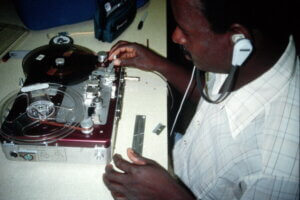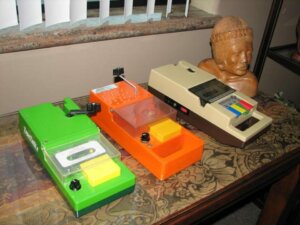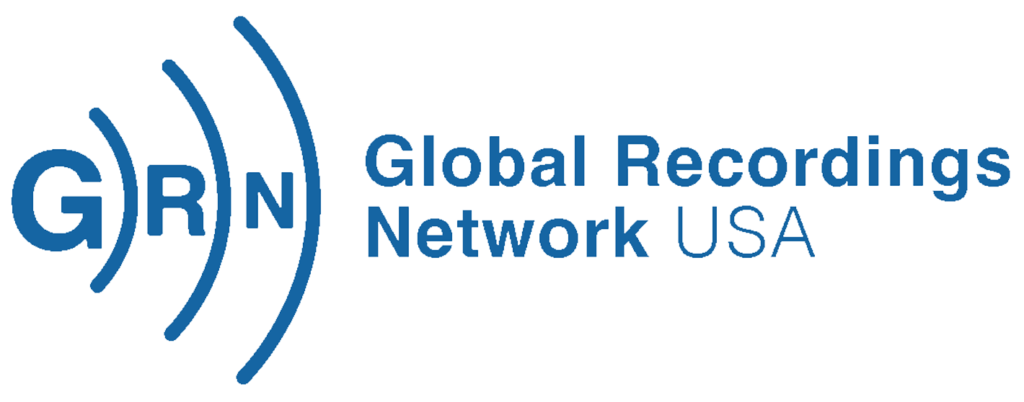From Sounds of GRN magazine (2024)
Even More Changes
by Ed Young
Ed Young, whose involvement with the mission goes back to the mid-’60s, has pretty much “seen it all.” He makes the understated comment, “Things are different today.”
Travel and recording, production and distribution of the tools, all are worlds away from what they were when Joy and Ann made the first recording trips of length in the 1940’s.
TRAVEL

When Joy Ridderhof and Ann Sherwood first started going to field locations, Mexican roads were the kind 4×4 owners of today look for to give their vehicles a challenging trial.
The 1700-mile-long Alcan highway, built during WW II and connecting the lower 48 states to the Alaska Territory, had only been opened to the public for three years when Joy and Ann headed to Alaska via a loaned Pontiac station wagon to record among the northern Indians and Eskimos. The Alaska trip took the five summer months of 1945, and while facing glaciers and rocky valleys, Joy heard of and started to dream of sandy beaches and palm trees in a much different theatre – the Philippines.
Ship travel was about 25 mph so it took 28-30 days for the ladies to travel from Los Angeles to the Philippines. Air travel was available but very costly. It became much more common by the 1960s.
RECORDING
The first recording equipment was complicated. A disk was cut with a stylus while recording – playback was impossible as the recording itself was destroyed. (It took a miracle to bring hundreds of uncensored —because unable-to-be-listened-to— disks out of Mexico during WWII). In addition, no editing was possible. The equipment was bulky and too heavy to unload easily from a vehicle.
In 1946 the first consumer tape recorder was invented. Sound was captured on paper tape coated with magnetite powder. 1947-48 saw an advancement – polyester tape coated with oxide. Joy’s first “tape” recordings were done in Alaska from the back of that Pontiac.

GR engineers invented the first spring-wound, hand-cranked tape recorders – the Minidyk and the Ready Corder. Eventually battery operation was standard with the Swiss-designed commercial Nagra series, used for many decades starting in 1957. Editing was dependent on grease pencils and splicing blocks.
Digital recording, introduced in the 1990’s, changed all that. First DAT recorders and now MixPre computers are the norm, and all editing is done by computer.
Electricity was slow in coming to many countries, was usually limited to the larger cities, and often rationed for parts of the day. While Joy and Ann took their own generator with them, later recordists were happy to use batteries. That has been replaced in many places by solar power.
Back then, any language research was done in public libraries or from mission bookshelves. Paper maps were created for well-planned trips. Language research today is all done online. Even that has been improved greatly with our new GRN MapApp, which puts a roomful of research at one’s fingertips.
PRODUCTION
In the 1940s, 78 rpm records were 10 or 12 inches in diameter, containing only 3 1/2 minutes of audio per side. The disks that Joy and Ann recorded onto were soft vinyl records. Electroplating produced metal stampers which were affixed to manually-operated steam presses. In the 1950s, GR Los Angeles began setting up their own record presses, and later in other countries. All stampers were made in LA.
For playback equipment, at first GR simply repaired old spring-wound gramophones. Then our engineers saw the need for low-cost, compact, portable, and light-weight players. They designed several with sturdier springs and unique speed governing systems, to be continuously cranked. To keep these sturdy players from being pirated, GR decided to only make 8-inch record-playing machines and matching 8-inch records. Over a million of these were produced in LA, and several million at other centers. We even modified a lightweight cardboard foldable player, the CardTalk — once seen never to be forgotten!
DISTRIBUTION
Later, cassettes could be played on any commercial player. But batteries were expensive and not available in remote areas. Once again, our engineers designed hand-operated players, and later those with solar capabilities. Portable generators assisted duplication of cassettes on-site for large-scale outreach.
Today, we still send a few devices loaded with messages around the world. But the digital age allows access to websites containing ALL GRN’s recordings. Micro-SD cards are loaded for some areas of the world. Mini projectors and fold up screens allow projection of Good News and other picture series for large groups. The availability of cell phones worldwide means that our 5fish app can be accessed online with connection to internet or downloaded and taken anywhere – providing access to our complete audio library.

